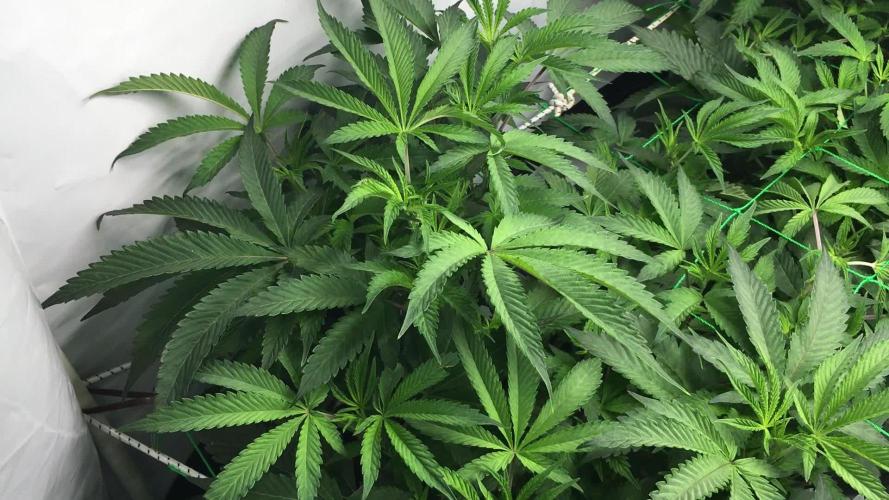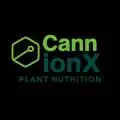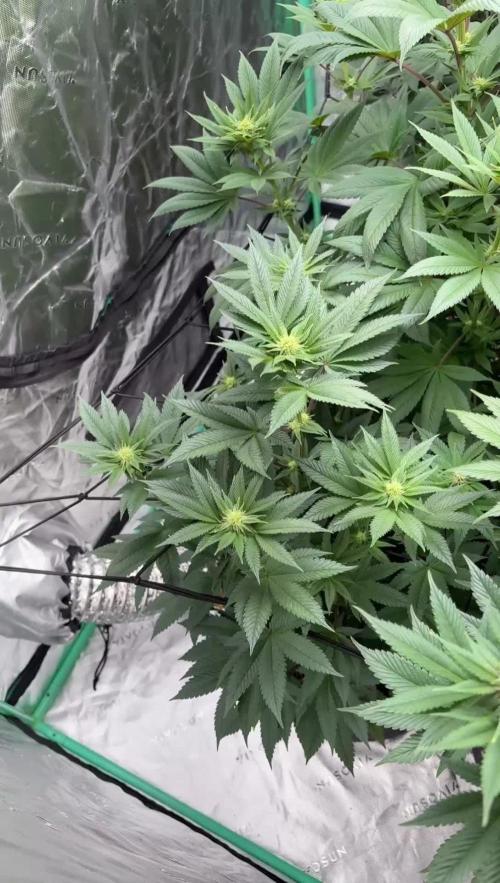The Grow Awards 2026 🏆 





























Likes
23
Share


@Canadian
Follow
I end up super cropping all the branches because they grow weight too big the good thing is that the plant has recover very well and starting to build up all those flowers.
I stopped recording their height at 71 inches but for sure if left alone she will continue to grow even more for now it looks like her flowering stretch has ended. I'm definitely looking forward to see how this girl is going to end up and at the end how much weight it is going to be able tohave.
thank you for reading I will continue to update have a happy grow.
Likes
10
Share


@barlobruz
Follow
08/30/2021
- Noticing more gnats than usual. Could be overwatering, anaerobic soil conditions, or both.
- Going to set up fly traps, starve both the plant and the gnats of water for about a week.
- Will observe any stress responses due to an extended dry period.
Likes
10
Share


@GreenCosmos
Follow
If you see any mistakes or you've suggestions/tips and tricks, please let me know! Thanks!
-----------------------------------------------------------------------------------
Big thanks to Zamnesia for providing me free seeds!!!
----- WELCOME -----
to my second grow with autoflowers, fourth overall.
This time with fancy F1 Hybrid seeds!
Thanks to Zamnesia for giving me the opportunity to try these luxurious seeds!
Zamnesia's Do-Si-Dos from last grow still makes me happy every day!
I’m so excited for the coming weeks and i hope that 4 plants aren’t to much for my little tent.
My last autoflowers were not very successful, but I’ve learned from them.
For the next few weeks I’ll start with only water (pH around 6.4) and introduce fertiliser very slowly.
This time I’m using BioBizz-Products (incl. BioBizz-LightMix) because LightMix is good for autoflowers and I didn't have to buy anything new.
I’m not completely sure if defoliation is a good idea, bud maybe I’ve to do it because of the small space.
----- Germination -----
4 Peat Pellets with 26ml water each. Every 12 hours I’ll spray them with water.
Had them in darkness for the first 24 hours.
After 72 hours (01/26) 3 out of 4 seeds came to life.
After 96 hours (01/27) all 4 seeds were successful and I transferred them to there new BioBizz LightMix home.
On day 5 I gave each plant 250ml ph-controlled water.
----- Preparations -----
A few days before starting I’ve dismantled my grow box to give it a deep cleaning.
Step 1: cleaning with soap water
Step 2: disinfection spray and let it dry
With this method I’ve cleaned everything involved.
My grow bags (13L - 3 gal) went into the washing machine with disinfectant detergent.
Additionally I’ve cleaned the complete room.
--------------------------------------------------------------------------------
Germination: 6 Days (01/23 - 01/29)
Vegetation: - Days
Flower: - Days
Light schedule: 18/6 // Distance: 30cm (12inch) // Power: 50% (75 Watt)
Humidity: ~80% // Temperature: 23°C ( 73°F)
Water schedule: 4 sprays with normal water every 12 hours
Information about Zamnesia Wurlz F1 Hybrid Automatic:
https://www.zamnesia.com/10669-zamnesia-seeds-wurlz-f1-automatic.html
Parents: Runtz x Watermelon Candy
THC: 24% // CBD: Low
Hight: 65-80cm (25.5-31.5 inch)
Time: 9-10 weeks from seed to harvest
Processing
Likes
5
Share


@Mr_nugs_lover_David
Follow
She's looking very healthy and strong after the transplant and I'm starting the lst on her too try to make a very nice and rounded bush full of tops. Let's see what happens with beauty, don't miss it! 💚 🌱 ✌️ 👨🌾
Likes
56
Share


@TOTEM
Follow
She loves her new home!!! 14cm from the lamp 🔥🔥I want huge buds, baby. This week I added Bug Bud. It’s so strange to treat an autoflowering strain like a normal one. But this plant has some amazing genetics. She loves to be trained, and she loves nutes as well. How can’t you love her? 😍
Likes
116
Share


@GMSgrows
Follow
Girls will get a feed of 400 ppm 0.8 ec of Massive Bloom Formulation, 600 ppm 1.2 ec of Flora Nova Bloom, and 200 ppm 0.4 ec of Floranova grow for a grand total of 1200 ppm 2.4 ec.
Girls are stacking, node spacing is close. Smell is amazing and she is a very healthy big bush.😍
Likes
34
Share


@Roberts
Follow
Blue Dream Auto grew okay. She didn't get as big as I expected, but I was not able to keep grow temp up due to the winter. She is loaded in trichromes and has a berry, woody, citrus aroma. I am gonna cut her today and get back with a smoke report soon. Thank you Seedsman, and Medic Grow. 🤜🏻🤛🏻🌱❄️
Thank you grow diaries community for the 👇likes👇, follows, comments, and subscriptions on my YouTube channel👇.
❄️🌱🍻 https://www.seedsman.com/?a_aid=Mrsour420.
This is my affiliate link to seedsman.
Thank you Happy Growing 🌱🌱🌱
https://youtube.com/channel/UCAhN7yRzWLpcaRHhMIQ7X4g.
Likes
10
Share


@PolezGardn
Follow
week two flower everything looks healthy :D
today i defoliated them
i watered them with 1.5l every 48h
the light i use was set to 80% and it hangs 80cm away from the tops
Likes
127
Share


@DreamIT
Follow
🎃👹👽MONSTERCROPPING RED MANDARINE 👽👹🎃
____________________________________________________________________________________
💀 19.2
💀 20.2
💀 21.2
💀 22.2
💀 23.2 vacation week
💀 24.2
💀 25.2 ...
____________________________________________________________________________________________
📜👀 A look at the details of what I'm growing 👀📜
🍊💚 Red Mandarine F1 🍊💚 by 🌱🍭 Sweet Seeds 🍭🌱
📋 Details
⚧ Gender
▪️ Feminised
➰ Genes
▪️ 55% Indica / 45% Sativa
🎄 Genetics
▪️ Red Poison Auto (SWS39) хCalifornia Orange x Skunk hybrid)
🚜Harvest
▪️ 400 - 500 g / m²
🌷Flowering
▪️ 49 - 63 days
✨THC
▪️ 16%
✅CBD
▪️ 0,2%
🏡Room Type
▪️ Indoor
🌄Room Type
▪️ Outdoor
🕋Room Type
▪️ N/D
🎂Release Year
▪️ 2019
__________________________________________________________________________
👀📷🥇 Follow the best photos on Instagram 🥇📷👀
https://www.instagram.com/dreamit420/
🔻🔻🔻Leave a comment with your opinions if you pass by here🔻🔻🔻
🤟🤗💚Thanks and Enjoy growth 💚🤗🤟
Likes
41
Share


@Kush_queen
Follow
So I had to trim these ladies they desperately needed it
These ladies are getting nice and smelly fruity smell filling the tent there are plenty of crystals coming and the buds are bulking out filling up the stick
I am looking forward to these 🌱💚💨💯🙏
Likes
5
Share


@Brendanfromtherose
Follow
I've brought the PPM down again and kept the pH at 5.7-5.8, plant looks great first grow so very happy, Alot of Trichomes and don't know if I should be getting ready to flush and harvest, buds still getting fatter and she's still thirsty and drinking water but a lot of amber pistils and not sure if the crystals are clear or Milky but plant looks Great, just unsure when to harvest,
I've reduced nutes a little more and calyxs still fattening up, gonna hopefully start flushing at end of this week for about 2-3 days in my 4gallon bucket
Likes
28
Share


@Bongman
Follow
Yoyoyo.... Another BM update:
Its week 7 and they are looking good... Buds are bulking up now and its almost time to defoliage and let the light shine thru to the bottom buds. I am going to wait another few days before I defoliage this mother. Will update more soon.
Happy growing,
BM
4TweentY
Likes
10
Share


@Canna96
Follow
Hey now, hope everyone has been well. Super excited football season is finally here so things are about to get busy. I went out of town for 4 days and the plants struggled a little bit with the PH getting slightly too high before I returned. I also came back to see that some type of insect was munching away on the lower leaves of my Sundae Driver which I sprayed the plant and coco with neem oil, but hopefully they didnt do much damage before I can get them under control I have never experienced insect problems indoors, likely because I grow in Coco and not Soil. However, I left a 5 gallon airpot full of coco from a previous grow outside for a couple weeks by mistake, and pretty sure bugs got into. I wont make that rookie mistake again. Anyways the rest of the ladies are looking pretty good, They are almost getting what I consider a full dose of nutrients, even though it half of the manufacturers recommended dosage. I am feeding all Gen Hydro cal mag, Armor Si, and maxi grow. I also add some food grade hydrogen peroxide to keep the reservoir fresh for around 10 days or so but I clean it once a week. Not sure why I cant select them on this site anymore, I know they got sold but they don't list them under either name. I did get all the ladies transplanted from solo cups to airpots on day 16, and it took 24 hours or so for them to recover from the transplant and start growing again. I am running 3 of the 3.4 gallon, and 2 of the 5.4 gallon just because that is what I had available. I hopefully top them all sometime this week for the first time, as soon as the roots are a little stronger. I let them grow to 7 nodes or so before I top them and make sure they're growing fast. Hopefully I can still mainline the Sundae Driver, she looks healthy other than those two leaves chomped off.
I dont really do any LST until I get get the first toppings done, because my primary goal at this stage is to ensure she grows a strong set of roots before I start manipulating her.
All the plants are on their 5th nodes, except for this Green Crack 2.0 which is only on her 4th node. We got another heat wave coming through my region that I am not too excited about but at least its earlly in the game and I dont need to crank this light up yet. I am only running it at 30% and its putting off plenty to keep this ladies happy. Hoping to get a topping done this week, then another one next week, and be ready to flip to flower by week 7 or so. Thanks for stopping by, Stay Safe and Blaze On!!! 💪
Website: https://medicgrow.com/
https://growdiaries.com/grower/medicgrowled
Likes
28
Share


@foxbberg
Follow
Flipped to 12/12 at day 43.
Raised light-intensity from 60 to 90 %.
Now +70% of the net is filled and i can see potential to make it an evenly shaped bowl full of fruits:-)
The deep, dark colour has turned to a juicy green, shoots everywhere....... everything fine but two little things:
1) run-off-pH is a bit high...... 6.6-6.9. will feed rather acidic next time....
2) Main Colas get a bit tall..... will supercrop them as soon, as the rest of the cannopy is organzied to a clean scrog.
Nutritionwise i lowered N, raised K and gave an extra P-shot (0,05 g/L BLOSSOM-BOOST) on days 43 and 44.
Day 45
fed pH 5.8 - readings immediatly dropped to 6.3 to 6.5 👍
Vigorous stretch.....!!! Mounted some more hooks to get the scrog even - works perfectly now! +80% of the net is filled......and the colas in the corner almost make plants of their own - i will supercrop them, as soon as they don't stretch any more.
Day 46
fed pH 6.1 today..... readings still good (average 6.4)
took out some more leafs today, to give a little more light to young shoots.
Smell is getting stronger, but no visible signs of flowering yet.
Likes
17
Share


@902EastCoast
Follow
Well started scrog. Transplanted 2 Barney’s farm Critical kush into 5 gal fabric pots. I’ve been using 400 watt setting with a mh bulb. Ran into a little problem with leaf septoria. First grow learning happening here!! Lol



























